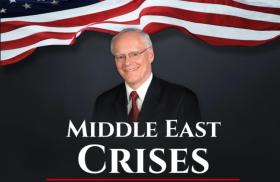
- Policy Analysis
- PolicyWatch 4105
Toward a More Comprehensive (and Effective) U.S. Policy on Yemen

The Houthis pose even more of a risk to U.S. and Gulf interests than they did before the Gaza war, so Washington and its regional partners need to develop an approach that is more fit for purpose.
U.S. policy toward Yemen is adrift. After an Omani-brokered truce halted a nearly two-month American campaign against the Houthis in May, the Trump administration quickly shifted to other priorities, even as Israel stepped up its own air campaign to curtail the group’s continued missile and drone strikes. If past is prologue, such air operations will neither deter nor uproot the Houthis, and may even work to their advantage.
The administration’s desire to pivot away from Yemen is understandable, but also shortsighted and potentially dangerous. President Trump may be done with the Houthis, but the Houthis are not done with the United States or its allies. What is needed is a more comprehensive Yemen policy in coordination with Gulf partners.
Shifts in U.S. Policy
Washington’s approach to Yemen has changed dramatically over the past several years. At the start of the Biden administration, diplomacy was front and center, aimed at ending the country’s civil war and the hostilities that had drawn in a regional coalition led by Saudi Arabia. This included reversing President Trump’s first-term decision to designate the Houthis as a Foreign Terrorist Organization (FTO)—a shift aimed at avoiding potential humanitarian consequences and assisting UN-led mediation efforts. The administration also increased pressure on Riyadh to end the war by suspending U.S. sales of offensive weapons to the kingdom.
Circumstances changed in November 2023 when the Houthis launched a concerted campaign against commercial shipping in the Red Sea in the name of supporting Palestinians during the Gaza war. The Biden administration shifted in response: it resumed offensive weapons sales to the Saudis, listed the Houthis as a Specially Designated Global Terrorist entity, conducted limited strikes on military targets in Yemen, and froze the diplomatic track. Ultimately, the administration made clear that as long as the anti-shipping campaign continued, the United States would oppose any agreement that might enable the Houthis to reap financial benefits.
When President Trump took office again this year, he adopted an even more muscular approach, at least at first. On March 4, the administration relisted the Houthis as an FTO—a more stringent designation that criminalizes material support. And on March 15, it launched Operation Rough Rider, a more intensive, sustained air campaign aimed at restoring freedom of navigation, targeting Houthi military personnel, and otherwise degrading the group’s capabilities.
On May 6, however, the operation ended as abruptly as it had begun, cutting short a quite costly and increasingly open-ended campaign that was depleting resources needed in other theatres. Conversations with officials in the internationally recognized Yemeni government in Aden indicate that the halt was a surprise, exposing their inability to act even with the United States on the offensive. For Saudi Arabia and the other main Gulf actor in Yemen, the United Arab Emirates, the decision reinforced perceptions of U.S. unreliability and policy volatility. Meanwhile, the Houthis emerged battered but not beaten—their leaders touted surviving a U.S. military onslaught as a victory and were likely relieved to take Washington out of the equation so they could regroup and focus on attacking Israel.
The administration’s current approach seemingly amounts to placing the Houthis on a slow simmer and leaving the kitchen. Washington has maintained the bilateral truce while applying pressure through the FTO mechanism, but there is no longer a U.S. special envoy to Yemen, signaling that the issue has been deprioritized. The administration has also ended virtually all foreign assistance to Yemen, including government-controlled areas that oppose Houthi expansion.
An Evolving Problem Set
Prior to the Houthi escalation during the Gaza war, Saudi Arabia, Oman, and the UN had made significant progress toward a roadmap agreement in Yemen with full backing from all five permanent members of the Security Council. This roadmap included a ceasefire, economic confidence-building measures, and the start of a political process to end the civil war. Essentially, the idea was to bear-hug the Houthis with diplomacy, accept them as part of Yemen’s political system, and bring them into an internationally backed agreement. As part of that process, Saudi Arabia and the United States aimed to use a combination of carrots and sticks to peel the group away from its top patron, Iran, and tie it to the Arab Gulf states instead. Yemeni government officials had serious reservations, but their main backer in Riyadh was determined to end a long and bloody war, so a deal appeared within reach.
Today, the Houthi challenge is much more dangerous and complex. Once focused primarily on Yemen, the group is now prioritizing long-term regional power projection. In addition to disrupting commercial shipping in the Red Sea corridor—an area that accounts for 12 percent of global trade—the Houthis have proven their ability to attack Israel over 2,000 kilometers away. The latter fight in particular has brought them regional popularity, more recruits, and invaluable military experience. It has also generally played to their advantage domestically—many locals support the group’s willingness to confront Israel, and even those who may oppose Houthi prioritization of regional aims over domestic needs dare not speak out amid a brutal, paranoia-driven crackdown on anyone the group labels a spy.
Taken together, the experience of the past two years has empowered messianic and expansionist elements in the Houthi movement while sidelining its more pragmatic nationalist elements. The movement’s leader, Abdul-Malik al-Houthi, has made numerous remarks casting himself as the spearhead of regional change, opposing both Western/Israeli “hegemony” and Arab governments aligned with the United States.
Putting this genie back in the bottle will be challenging at best. Although the Houthis have promised to end their missile and drone campaign if Israel and other parties reach a ceasefire in Gaza and lift the blockade there, it is uncertain whether this would remove the threat to the Red Sea over the long term. Now that they have benefited from exerting this leverage, it is difficult to see why they would not use it again, whether in response to another Israeli-Palestinian flare-up or to extract future concessions from Saudi Arabia or other states.
Moreover, while the Houthis still depend on Iran for certain advanced capabilities like medium-range ballistic missiles and antiship cruise missiles, they are nimbly expanding their domestic manufacturing and diversifying their supply chains to include dual-use Chinese components. They are also developing ties with the militant group al-Shabab across the Gulf of Aden, supplying it with weapons in return for increased piracy and disruption of shipping off the coast of Somalia. In addition, the Red Sea campaign has brought them closer to Moscow and Beijing, both of whose vessels have largely been permitted to pass unmolested. Russia reportedly sent military advisors to Houthi-controlled Hodeida and even considered supplying missiles and other military equipment before Riyadh and Washington intervened last year. In short, the group is developing an ecosystem that is relatively insulated from U.S. sanctions and united in a desire to challenge the U.S.-led global order.
Of particular concern is the growing threat that the Houthis pose to other Gulf states—especially Saudi Arabia, which is at the center of ambitious regional plans to move away from oil-based economics and toward stable (albeit autocratic) economic and social transformation. The Trump administration has repeatedly stated its interest in helping these countries stabilize and integrate the Middle East in ways that expand America’s own influence and prosperity. Yet the Houthis’ growing capabilities and ambitions pose a direct threat to this central U.S. goal. The group has concluded that Riyadh wants calm above all else, making the kingdom susceptible to ever-increasing demands and leading many anti-Houthi Yemenis to worry that the kingdom will no longer use its air force to defend the frontlines (e.g., in government-controlled parts of Marib province).
Policy Recommendations
The current U.S. approach to Yemen is not fit for purpose. The Houthis pose more, not less, of a risk to U.S. interests than they did before the Gaza war. Although they will likely make good on their promise to halt Red Sea attacks if a ceasefire is reached in Gaza, the durability of this pause is questionable, and they seem inclined to pursue escalation on other fronts. In the meantime, their current battle with Israel might take a more dangerous turn—for example, if they threaten critical energy exports in the northern Red Sea, as they seemed to do by attacking an Israeli-linked ship near Yanbu earlier this month. Before the crisis evolves into something even worse, the Trump administration needs to develop a more comprehensive Yemen policy in coordination with Gulf partners.
The first step is to bring together a “Yemen team” to update U.S. policy internally and begin discussing options at a senior level with Gulf officials. Whether the choice is containment, confrontation, updated compromises, or some combination, the following measures will be critical:
- Work with Yemeni and Gulf partners to put a credible military threat back on the table. At minimum, government-aligned forces must be supported enough to hold current frontlines and launch counteroffensives. This entails continued air support from the Saudi-led coalition, especially in Marib and along the Red Sea coast.
- Provide clear security guarantees to Saudi Arabia and the UAE, such as additional arms sales, increased training and exercises, and a commitment to come to their defense if the Houthis attack.
- Provide unified support for Yemeni government reform. The internationally recognized government—especially its executive body—is divided and ineffective, and efforts to reform it have been slowed in part by the fact that Saudi Arabia and the UAE support competing factions. Senior U.S. officials can provide an invaluable convening role by bringing Gulf partners together on a strategic vision for supporting a reformed government.
- Do more to target Houthi arms and money. This entails working with Oman, the UAE, and others to improve weapons interdiction and stop illicit financial flows to the group.
- Restart a dedicated political process that explores potential off-ramps and a revised political settlement, including a Gulf-supported reconstruction and development package.
None of these options will have much traction if unilateral Israeli airstrikes continue. Accordingly, once the United States and its Gulf partners agree on a revised plan, Washington must do what is necessary to gain Israeli buy-in. Considering the Gulf’s growing frustration with Israel’s unilateral military action in the region and the perceived unreliability of U.S. security guarantees, working on the Yemen file together is a chance for vital confidence-building and cooperation.
April Longley Alley is a senior fellow at The Washington Institute and former senior political advisor to the UN special envoy for Yemen.



